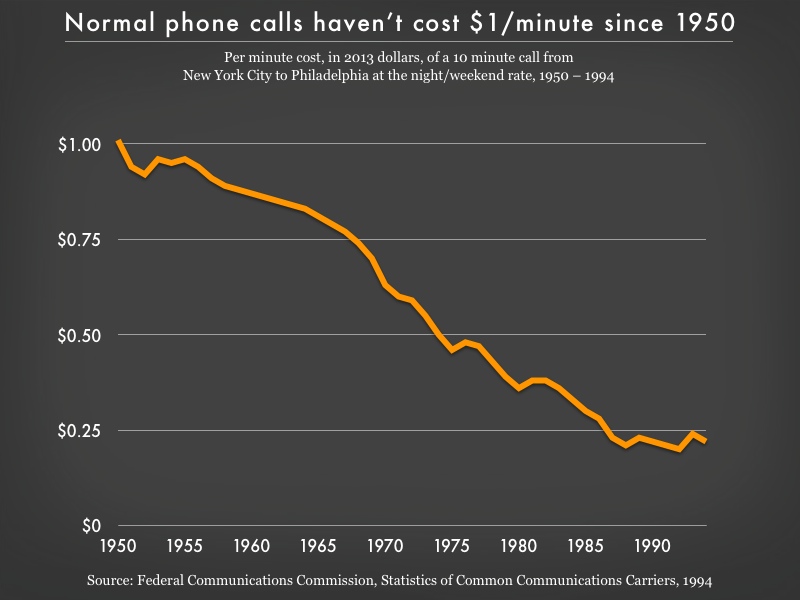Today the FCC dragged the prison telephone industry kicking and screaming into the 21st century
The two largest prison phone companies, mislead correctional facilities and federal regulators by acting like communications technology is stuck in the 1950s.
by Peter Wagner, February 11, 2014
Today is a historic day: the Federal Communications Commission’s new rules take effect that cap the cost for inter-state calls home from prison and jail at a still-expensive but much-improved rate of 21 to 25 cents per minute. The FCC is exploring expanding its regulation to apply to the bulk of calls which are in-state in nature, and other important proposed restrictions have been stayed by the federal courts while prison telephone giants like Securus and its corporate allies sue the federal government for daring to end the industry’s monopolist price gouging.
As we’ve demonstrated in several lengthy reports and filings to the FCC, the high cost of phone calls from prison is driven by a kickback system in which private companies get monopoly contracts in exchange for sharing the majority of the revenue with the same correctional agency that awarded the contract.
So while Securus sues to protect its windfall profits off the backs of families, I’d like to point out just how far out of step rates like $1/minute are in a world of modern electronic communications.
Contrary to what the phone companies would have you believe, important security technology isn’t what’s driving the cost of these calls. In fact, a call home from New York State prisons costs 4.8 cents a minute because that state refuses kickbacks and negotiates the contract on the basis of the lowest cost to the consumer. But the very same company charges close to $1/minute in other states. As we’ve said again and again, it’s all about the profit.
But aside from the contemporary arbitrariness of the charges in this industry, taking a look at the historical perspective sheds some additional light on why the FCC has to drag this industry kicking and screaming into the 21st century. You see, Securus and Global Tel*Link, the two largest prison phone companies, mislead correctional facilities and federal regulators by acting like it’s still the 1950s, when transmitting a long-distance call was a deeply expensive and laborious manual process.
 Why do most prison and jail phone contracts assume that a long distance call requires an army of telephone operators like the ones in this photo from 1919?
Why do most prison and jail phone contracts assume that a long distance call requires an army of telephone operators like the ones in this photo from 1919?
Check out this radio dramatization from Dragnet of a long distance call in 1954. That tedious 1 minute 22 second process wasn’t much better than the very first inter-continental telephone call in 1919, which took 5 operators 23 minutes to connect Alexander Graham Bell with his former assistant Thomas Watson. Fortunately technology has vastly improved since then, and these days prison and jail telephone companies sell digital communications products for which distance is simply not a factor. These companies know, however, that it’s in their best interest to leave sheriffs in the dark about these 21st century technological advances. With the possible exception of some of the smaller companies that are pushing one-size-fits-all “postalized” rates, the phone corporations don’t appear to be lifting a finger to educate the sheriffs about the real cost of the telephone services being contracted.
The industry’s lack of transparency about the actual cost of providing telephone service is quite similar to its practice of hiding fees, which we discussed in detail in our second report. Essentially, the phone industry rakes in additional profit by tacking on extra fees and hiding them from the commission system. As a result, the sheriffs are led to believe that they have negotiated a good deal with the phone company, but the hidden fees preserve far more profit for the industry than it lets on. That’s why our report included an appendix with questions that the sheriffs should ask about fees when negotiating these contracts.
So, at the end of the day, how far out of whack is a $1 a minute phone call? We did some research to figure out the last time a regular U.S. long distance phone call cost $1 per minute. Adjusting for inflation, a call hasn’t cost that much since 1950:





